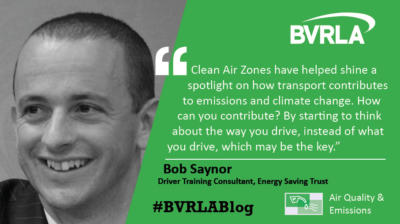Bob Saynor, Driver Training Consultant for the Energy Saving Trust shares driving advice that will not only reduce emissions but save on fuel and costs too.

My work with the Energy Saving Trust includes helping drivers to understand that to drive more efficiently saves on fuel, reduces carbon emissions and improves air quality by using a method called ‘Ecodriving’.
It’s a driving style that can help reduce fuel consumption, extend an electric vehicle (EV)’s range, cut carbon emissions and lower accident rates in any vehicle, whether it is conventional, electric or a hybrid. Reducing costs, cutting emissions and improving safety – in my opinion, that’s a Win-Win-Win.
The UK’s new Clean Air Zones and Ultra Low Emission Zones have helped shine a spotlight on how transport contributes to emissions and climate change, urging Londoners and others across the country to rethink their vehicle.
But how else can you contribute to this change, whether you’re in a petrol, diesel, electric or hybrid vehicle? Starting to think about the way you drive, instead of what you drive, may be the key.
Follow my tips to start reducing your fuel, emissions and costs:
- Drive smoothly to conserve momentum: By anticipating the road and other drivers ahead, you can avoid unnecessary acceleration and deceleration, therefore conserving momentum and reducing fuel consumption. Greater anticipation is the key to both efficient and safer driving.
- Change gear early: When accelerating it is most efficient to change up through the gears as soon as your vehicle will comfortably take the next gear. The actual RPMs will depend on the vehicle, the load, the gradient of the road and more, but for a car this typically means changing up by around 2000rpm.
- Lift off and drive for free: When slowing down, remain in gear but lift off the accelerator as early as possible. You’ll then be engine braking, with the momentum of the vehicle turning the engine. In a petrol or diesel vehicle this activates the fuel-cut off switch, which reduces fuel flow to virtually zero.
- Avoid excessive speeding: High speeds increase fuel consumption, primarily because of higher wind resistance. Travelling at 75mph in a petrol or diesel car will use around 18% more fuel than 60mph, and for a van the fuel consumption penalty is around 37%.
- Reconsider use of heating and air-conditioning: Air-conditioning adds significantly to fuel consumption for all vehicles. Opening the windows incurs a much smaller penalty even at higher speeds. If you are using air-conditioning, then adjusting the climate control setting up a degree or two will reduce the fuel consumption. Heated seats and steering wheels in an EV use less energy than heating the entire vehicle, and so these features are included in most EVs, including base models.
- Know your vehicle’s eco features: Many modern vehicles, whether conventional or plug-in, have features that can help you conserve fuel or battery. These include stop-start systems, gear-shift indicators, feedback on driver efficiency, and for most EVs an eco-setting which will typically limit acceleration and top speed and reduce the power of heating and air-conditioning.
As well as my top six above, you can improve your Ecodriving with a more immersive approach, funded Ecodriving training is available for organisations. Energy Saving Trust’s subsidised Ecodriving training delivers an average fuel saving of 15% on the day of training, and up to 6% in the long term for fleets. To date EST has funded training for more than 70,000 drivers of conventional and electric vehicles.





